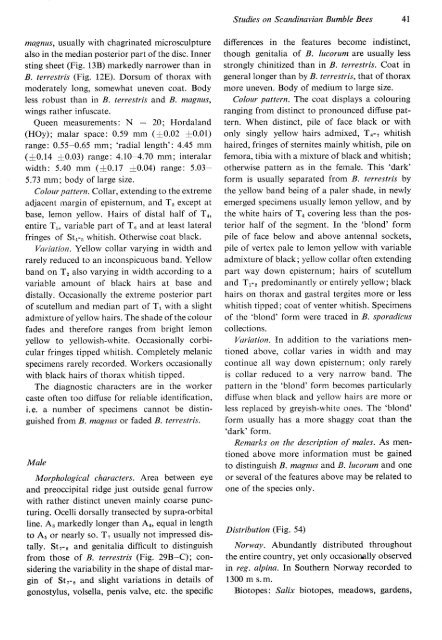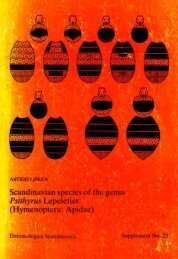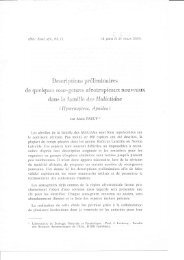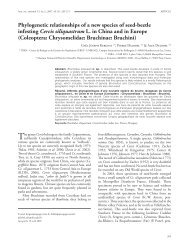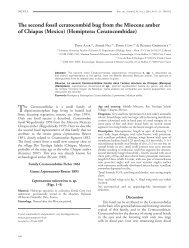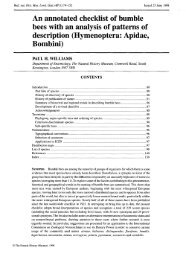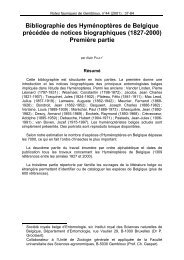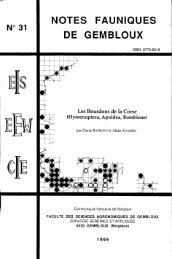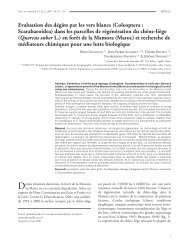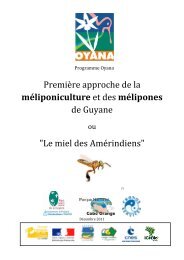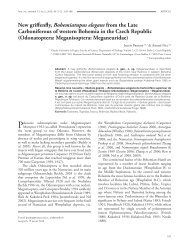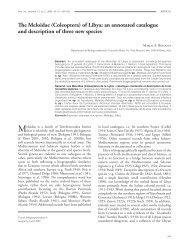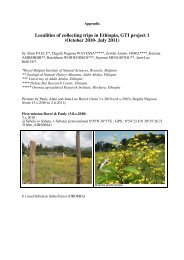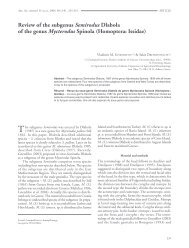Bumble Bees
Bumble Bees
Bumble Bees
You also want an ePaper? Increase the reach of your titles
YUMPU automatically turns print PDFs into web optimized ePapers that Google loves.
Studies on Scandinavian <strong>Bumble</strong> <strong>Bees</strong>4lmagnug usually with chagrinated microsculpturealso in the median posterior part of the disc. Innersting sheet (Fig. 13B) markedly narrower than inB. terrestris (Fig. lZE). Dorsum of thorax withmoderately long, somewhat uneven coat. Bodyless robust than in B. terrestris and B. magnus,wings rather infuscate.Queen measurements: N - 20; Hordaland(HOV); malar space: 0.59 mm (+O.OZ +0.01)range: 0.55-0.65 mm; 'radial length': 4.45 mm(+O.t+ +0.03) range: 4.10-4.70 mm; interalarwidth: 5.40 mm ( +0. tZ +0.04) range: 5.03-5.73 rnm; body of large size.Colour pattern Collar, extending to the extremeadjacent margin of episternum, and T, except atbase, lemon yellow. Hairs of distal half of Tn,entire Tr, vatriable part of Tu and at least lateralfringes of St^-u whitish. Otherwise coat black.Variation. Yellow collar varying in width andrarely reduced to an inconspicuous band. Yellowband on T, also varying in width according to avariable amount of black hairs at base anddistally. Occasionally the extreme posterior partof scutellum and rnedian part of Tt with a slightadmixture of yellow hairs. The shade of the colourfades and therefore ranges from bright lemonyellow to yellowish-white. Occasionally corbicularfringes tipped whitish. Cornpletely melanicspecimens rarely recorded. Workers occasionallywith black hairs of thorax whitish tipped.The diagnostic characters are in the workercaste often too diffuse for reliable identification,i. e. a number of specimens cannot be distinguishedfrom B. magnus or faded B. terrestris.MaleMorphological characters. Area between eyeand preoccipital ridge just outside genal furrowwith rather distinct uneven mainly coarse puncturing.Ocelli dorsally transected by supra-orbitalline. A, markedly longer than An, equal in lengthto Au or nearly so. T, usually not impressed distally.Str-, and genitalia difficult to distinguishfrom those of ,8. terrestris (Fig. 298-C); consideringthe variability in the shape of distal marginof St r-, and slight variations in details ofgonostylus, volsella, penis valve, etc. the specificdifferences in the features become indistinct,though genitalia of B. lucorum are usually lessstrongly chinitized than in B. terrestris. Coat ingeneral longer than by B. terrestrH, that of thoraxmore uneven. Body of medium to large size.Colour pattern The coat displays a colouringranging from distinct to pronounced diffuse pattern.When distinct, pile of face black or withonly singly yellow hairs admixed, T*-, whitishhaired, fringes of sternites mainly whitish, pile onfemora, tibia with a mixture of black and whitish;otherwise pattern as in the female. This odark'form is usually separated from B. terrestris bythe yellow band being of a paler shade, in newlyernerged specimens usuall.v lemon yellow, and bythe white hairs of Tn covering less than the posteriorhalf of the segment. In the 'blond' formpile of face below and above antennal sockets,pile of vertex pale to lemon yellow with variableadmixture of black; yellcw collar often extendingpart way down episternum; hairs of scutellumand Tr-, predominantly or entirely yellow; blackhairs on thorax and gastral tergites more or lesswhitish tipped ; coat of venter whitish. Specimensof the 'blond' form were traced in B. sporadicr,tscollections.Vuriation. trn addition to the variations mentionedabove, collar varies in width and maycontinue all way down episternum; only rarelyis collar reducod to a very narrow band. Thepattern in the 'blond' form beconaes particularlydifruse when black and yelloi.v hairs are more orless replaced by greyish-white ones. The 'blond'form usually has a more shaggy coat than the'dark' form.Remarks on the description of males. As mentionedabove more information must be gainedto distinguish B. magnus and B. lucorum and oneor several of the features above may be related toone of the species only.Distribution (Fig. 5a)Norway. Abundantlydistributed throughoutthe entire country, yet only occasionally observedin reg. alpina. In Southern Norway recorded to1300 m s.m.Biotopes: Salix biotopes, meadows, gardens,


